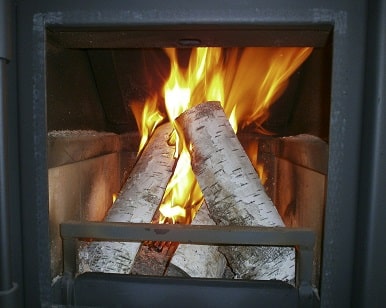Eco-Friendly Hearth Is Here to Provide a Luxurious and Comfortable Lifestyle
A hearth is a stone-lined or brick fireplace that may or may not contain an oven and is used to heat a space, cook, and heat water. It is made of non-combustible material that protects the burning logs, floor from sparks, radiant heat, and flying embers that may fall from the fireplace. Stoves, fireplaces, and inserts are the most common types of hearths. A fireplace is a framed opening in a chimney designed to accommodate an open fire. Gas, electricity, wood, and pellets are all choices available for heating a hearth or fireplace. A stove is a self-contained building that generates heat by burning renewable cordwood or fuel pellets derived from condensed biomass resources such as wood chips and sawdust. A stove, either gas or wood, that is designed to be fitted into an existing fireplace is known as an insert.
Desire for Luxury Travels and Leisure Experiences Have Paved the Way for the Hearth Market
The growing demand for modern infrastructure in countries is the primary demand driver of the industry. The demand for an improved fireplace technology for a better lifestyle will expand as global average disposable income rises, as will investment in modern residential or commercial infrastructure. Furthermore, the rise in global travel has moved demand for greater facilities for comfortable stay, expanding tourist sector potential, especially in colder weather conditions. Installation of such appliances in restaurants, hotel chains, and cafeterias for a luxurious experience for customers is a commercial application of hearth technology. The expanding tourism industry is a major contributor to the increase in commercial hearth demand. Furthermore, in addition to the disposable cash that supports tourism, internet penetration has allowed for the reduction of time-consuming research and expenses via using intermediaries, providing tourists more leverage. Tourists can get a clear picture of a hotel’s or restaurant’s service by using online review and rating systems, which puts pressure on the latter to improve their services.
The Market for Hearth Technology Is Bound to Shrink as the Earth’s Temperature Rises
Excess carbon emissions by humans have resulted in a rise in global temperatures, limiting the demand for hearths. The temperature of the Earth is rising at an alarming rate, according to data from the National Ocean and Atmospheric Association, NOAA. The Earth’s temperature rose at a rate of 0.13 degrees Fahrenheit every decade until the 1800s when it doubled. According to the NOAA, the global average ocean and land temperature in 2020 was 1.76 degrees Fahrenheit higher than the decade average. To keep occupants warm within their structures, hearth technology is most commonly used in areas with extremely cold climates. As the temperature rises, these places will experience less cold weather and cold waves, lowering demand for the hearth market.
Gas-Based Hearth Devices to Escalate Owing to Aesthetic Appearance Whereas Electric Hearth Devices Will Rise Due to Technological Advancements
The usage of conventional wood-styled hearth devices is expected to decline significantly. Furthermore, escalating deforestation and environmental issues limit the use of wood for heating purposes. However, gas-fueled fireplaces will have a significant market share. European consumers are falling in love with the aesthetic attraction of gas fireplace designs, innovative functions, modern style, and a wide display of flames. This is a recent trend in Europe, but it has been present in the North American market for quite some time. Gas fireplaces are gaining market share by advertising their exquisite designs, and many manufacturers are looking for characteristics that would set them apart from their competition. The electric type hearth devices, on the other hand, are expected to increase at a high rate in order to reach a significant market. Electric-styled hearth devices are pollution-free, cost- and space-efficient, and produce no waste, so they will have a large market. Furthermore, electric-styled hearting devices installed in hotels and restaurants may be controlled remotely, making them much more convenient to use. The use of an electronic ignition system improves the hearth’s total heating efficiency as well as the safety features and additional functionality it provides, boosting the hearth’s overall performance. In addition, in many parts of North America, hearth manufacturers are required to offer only devices that use an electrical ignition mechanism.
Regions With Colder Climates Are Expected to Drive the Sales of Hearth Appliances
In countries with very freezing weather, a hearth is a practical alternative for room heating that also helps to reduce electricity expenditures when compared to other space heating systems. According to the Tyndall Centre for Climate Change Research, the UK, China, Russia, Germany, Ukraine, and Poland are the top countries with mean temperatures of less than 10 degrees Celsius. In these countries, hearths are commonly used for heating and cooking in homes, cafes, restaurants, and other indoor locations. As a result, chilly weather conditions across various regions, as well as the widespread use of a hearth in these places, will drive market expansion during the projection period. The North American and European markets have significant shares whereas due to the thriving tourist business, the Asia Pacific area will likewise grow at a rapid pace. The region’s expanding tourist industry, particularly in China and India, is likely to increase demand for hearths used in the hospitality sector.
COVID Insights
The coronavirus epidemic has a negative impact on the hearth market’s growth globally due to a reduction in demand. The government’s containment measures resulted in sluggish growth. As a result, household spending shifted away from décor and infrastructure and towards necessities. Tourist visits across nations and within countries were put on a standstill as a result of the lockdown and other travel restrictions put in place to halt the Covid-19 outbreak. The hearth market shrank even further as hotels and restaurants closed their doors during the pandemic.



